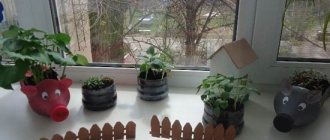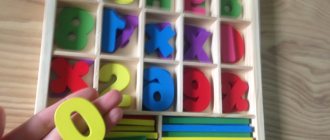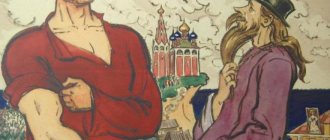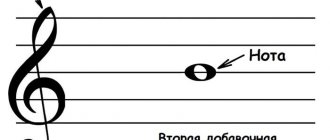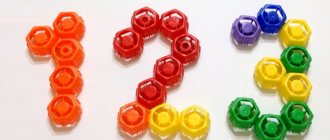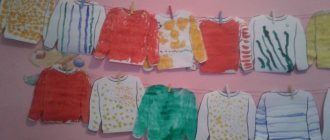Educational zone "Secrets of Space"
Participants of the exhibition-competition:
The team of the Isetsky kindergarten “Sun”
branch of MADOU "Isetsky kindergarten "Ivushka"
head of the automotive team:
senior teacher Pakhomova Elena Nikolaevna
Age category – middle and senior preschool age
Purpose of the manual: Formation of elementary ideas about outer space among preschoolers.
Objectives of the manual:
Educational
- Motivate preschoolers to use different sources of information
- To form and enrich knowledge about the Universe.
Developmental
- Develop children's cognitive interests about the solar system.
- Expand children's knowledge about space explorers
- Activate the dictionary on the topic “Space”.
Educational
- Foster a sense of pride in your homeland.
- Foster love for your planet.
Principles of constructing a subject-development environment
The educational environment created by the hands of kindergarten teachers meets modern requirements for constructing a teaching and learning environment.
1) Saturation of the environment - corresponds to the age capabilities of the children and the content of the Program. In the middle group, children are introduced to the topic “Cosmonautics Day. Starships"; in the senior group – we are working on the topic “Cosmonautics Day. Cosmonauts"; in the preparatory group - “Cosmonautics Day. There are distant planets in space orbits"
The educational space is equipped with teaching and educational means (Zones “Constellations”, “Solar System”, “Space Conquerors”, busy boards, “Starships”). It provides:
-game, cognitive, research and creative activity of all pupils, experimenting with materials available to children (balloons);
- motor activity, participation in outdoor games and competitions, because located in a wide corridor where you can gather children and have educational conversations and sports games; To conduct “Fun Starts” you can go to the gym located next to the “Secrets of Space” zone.
- emotional well-being of children in interaction with the subject-spatial environment - children are happy to examine and engage in the created educational environment;
- the opportunity for children to express themselves - during organized conversations with children, they share their existing knowledge about space, which they received from cartoons, books, TV shows and the Internet.
2) Transformability and multifunctionality - the created educational zone assumes the possibility of changing the posted materials depending on the educational situation, on the changing interests and capabilities of children.
For example, when children remember the placed constellations well, it will be possible to design others; You can place the zodiac constellations according to the seasons. The free area in the educational zone can be changed using the “Space Experiments” laptop, soft modules can be used to create a rocket or labyrinths on other planets.
3) Variability of the educational zone:
— the presence of various zones for children’s education (didactic games, constructing from flat geometric shapes, experimenting with balls), children can choose the game they like, using busy boards to study a rocket, a spacesuit, the solar system;
— Used integration of educational areas in working with children
Cognitive development:
- enriching and expanding children's knowledge about space, namely, cosmonauts, coherence, accuracy in their work;
- familiarization with the names of tools and equipment necessary for work at the cosmodrome;
- Organize educational projects, examining images of planets, constellations, a model of the solar system, illustrations and books on the topic “Cosmos”, observing the sky, stars during the dark, the Moon during a walk: new moon, month, half moon, full moon; experiment with a globe and a lamp “Day and Night”.
Speech development:
- the ability to communicate in business and play with the teacher and peers, the desire to participate in joint collective activities;
- the use of dialogic speech, the ability to develop dialogue in various cognitive situations; the ability to share your own experience gained previously;
- Carrying out joint activities with children “Conquest of Space”, memorizing poems about space, guessing riddles, writing stories on the topic “Space Stories”
Artistic and aesthetic development:
- formation and activation in children of manifestations of an aesthetic attitude towards the world around them in various situations, towards different objects, celestial phenomena;
- development of children's creative abilities in free and organized artistic activities.
- Organization of creative drawing “Aliens, what are they like?”, “Cosmonauts”, “Cosmonaut Training”, “Northern Lights”, application “Starry Sky”, “Rocket”, modeling “Rocket”, “Alien”
Social and communicative development:
- Encourage children to develop role-playing and didactic games on the topic “Space”;
- To develop the social and personal qualities of each child: communication, independence, observation, skills of basic self-control and self-regulation of their actions.
- Conducting thematic conversations and educational activities “Let’s help the inhabitants of a sad planet”, “What will happen to our planet if ...”, communicative games, intellectual game “Journey to distant planets”
Physical development:
- harmonious physical development of children;
- physical activity;
- physical qualities in children: general endurance, speed, strength, coordination, flexibility, spatial orientation.
- Conducting outdoor games, thematic physical education classes “Training future cosmonauts”, entertainment “The Road to Space”.
4) Availability of use of the educational zone:
- because the educational zone is located in the corridor, then children have free access, including the opportunity for parents to study with their children, examine materials, draw and sculpt;
- serviceability and safety of materials and equipment - all materials used in the lapbook or on the wall are completely laminated, so they can be used for a long time, teachers and parents can take cards to groups / home for free organization of children's activities.
5) Safety – All materials used in the educational environment are of good quality and correspond to the age capabilities of the children. The placed business boards have certificates of quality and safety of their use; The educational area is located in a room well lit with artificial light.
Description of the practice of working with children in an organized space
The educational zone was created to organize educational activities for children of middle and senior preschool age.
The educational zone “Secrets of Space” consists of 3 development centers - decoration on the wall, laptop “SOYUZ Rocket” and Celestial Space.
Educational zone "Secrets of Space"
The development zone decorated on the wall consists of 4 centers:
1 center – Set of business boards “Space Wonders” - consists of “Rocket”, “Cosmonaut”, “Solar System” and “Satellite”. For working with each busy board, kindergarten teachers have developed methodological recommendations.
The multi-colored doors, clasps and various labyrinths used in business boards help children develop fine motor skills, teach them to think logically and develop cognitive skills.
Kindergarten teachers made models of a rocket and an astronaut, with a hole for the face. Parents will be happy to take photos of their children.
2 - helps educators tell and children get to know the first space explorers Belka and Strelka, as well as pilot-cosmonauts who made landmark flights in the history of astronautics: Yuri Gagarin - the first pilot-cosmonaut; German Titov is the second cosmonaut pilot, he flew into space 4 months later in August; Valentina Tereshkova - the world's first female cosmonaut; Georgy Grechko - flew into space 3 times; Alexey Leonov - the first cosmonaut to walk into outer space; Svetlana Savitskaya is the first female cosmonaut to go into outer space.
3 - 9 planets, arranged in a row, in accordance with their location in the solar system.
Mercury is the planet closest to the sun and moves across the sky faster than other planets;
Venus is the second planet farthest from the Sun in the solar system; it is very similar to Earth, so it is considered Earth’s sister.
Earth is the third most distant planet from the Sun in the Solar System. The densest, largest among the terrestrial planets.
Mars is the fourth farthest from the Sun and is often called the “red planet” due to the reddish hue of its surface. If the wind blows on it, a storm will begin that can last for several months.
These 4 planets belong to the terrestrial group because they have a solid surface.
The next 4 planets are classified as giant planets.
What does the word giant mean? But, they consist of gas. Do you think it’s possible to walk on them since they are made of gas? These are the planets - Jupiter, Saturn, Uranus, Neptune.
Pluto is the farthest planet from the sun, it is called a dwarf planet, it is very cold on it. Why do you think? The average temperature there is 229 degrees, but here in Siberia, when it’s cold, the temperature only drops to -45 degrees.
In this area, the children and I will play educational games.
— “Find out the planet by description”
Didactic task: teach to perceive descriptions by ear
Game task: guess which planet we are talking about.
— “Put an animal on the planet”
Didactic task: determine the first sound of a word; name representatives of the animal world using a given sound; develop phrasal speech.
Game task: I propose the game “Place an animal on the planet.” Whoever has the ball left at the end of the words determines what letter the planet begins with and remembers the animals that begin with this letter: Mars - I will put a mouse and a bear on Mars, Saturn - a dog, etc.
4 - In this zone, children will get acquainted with the celestial universe and learn about the many different constellations in it.
At stage 1, the most famous constellations of Ursa Major and Ursa Minor, Cassiopeia, Cygnus, and Pisces are placed.
Over time, the constellations will change to others, for example, to constellations according to the signs of the zodiac.
In this area, the children and I will play educational games.
- “My Constellation”
Didactic task: to introduce children to constellations, their names, shapes. Develop abstract thinking.
Game task: I have prepared diagrams of the constellations for you. First, look at the map diagram, then use a marker to draw constellations on your diagrams.
For each described zone, kindergarten teachers plan to carry out project activities in April.
Lapbook “Soyuz Rocket”. The laptop is a folding folder made in the shape of a rocket. There are 2 portholes on the side walls. The laptop can be transferred to groups to play games, look at photos and get acquainted with various additional information on the topic “Space”:
- photographs of astronauts in orbit and in the spacecraft,
— riddles and poems about space objects,
— didactic game “Find the Alien Rocket” — Aliens have come to us
What rocket did you board on?
Look carefully
And find that rocket.
Didactic task: reinforce geometric shapes with children.
Game task: Carefully look at the pictures of aliens and determine which rocket each alien arrived on.
— didactic game “Dinosaurs” — The dinosaur got lost
He was left all alone
Where did he live, find the planet
After all, he has no friends.
Didactic task: to reinforce with children the colors and concepts of big, medium, small.
Game task: Guys, you have large, medium and small dinosaurs. Place large dinosaurs on a large planet, medium ones on a medium planet, and small ones on a small planet.
— didactic game “Choose a spacesuit by size” — For astronauts for flight
Everyone needs a spacesuit
Well, take a quick look
And pick up a spacesuit.
Didactic task: to reinforce with children the concepts of tall-short/big-small.
Game task: In order for an astronaut to go into outer space, he needs a spacesuit. There are three astronauts in front of you. Show the highest, the lowest. Let's select the right size suits for them.
— didactic game “Find identical rockets” —
Two rockets, two sisters
There are similarities.....
Find the difference.
Didactic task: teach children to find pictures that are similar to each other.
Game task: Look how many rockets have come to us, let's look at them and find the same rockets.
— board game educational lotto “Solar System” -
Here's the lotto in front of me
"Solar system"
Line up the planets
It won't be a problem.
Didactic task: teach children to recognize and name planets from pictures. Complication: give a brief description of the planets
Game task: I suggest playing lotto. I will name and show a picture of the planet, and you carefully examine it and look for it, if you have it, then tell me, and I will give you the card.
— didactic game “Put out the rocket” —
Me and my action figure friends
Let's build a rocket
It's a pity we can't fly
There is no fuel.
Didactic task: to develop imagination and creativity in children; fix geometric shapes and colors.
Game task: Belka and Strelka are getting ready to fly again, but their rocket is already quite old, let’s build them a new rocket.
— “Draw a rocket” —
And over the rainbow there's a rocket
Soared to the skies
I'm the same rocket
I'll draw it myself.
Didactic task: learn in stages, using step-by-step instructions to draw a rocket.
Game task: If you want to learn how to draw different rockets, then take in this pocket a card with the rocket you like. Look at the numbers and draw, starting with number 1.
— “Make a rocket” —
I will mold it from plasticine -
An astronaut, and then
I'll fly with him on a rocket
Straight into the sky - High!
Didactic task: teach step by step, using a model, to sculpt a rocket.
Game task: Aliens came to visit us - on a flying saucer. They are very interested in seeing our rockets, but we have a very long way to go to the cosmodrome. Let's make rockets. To make it correctly, you can take a card and, starting with number 1, build a rocket step by step.
- “Launch the rocket” -
Using countdown
Send the rocket into flight.
Didactic task: teach preschoolers to count backwards.
Game task: To send a rocket into flight, a countdown is carried out at the space test site - this is when the numbers are called in reverse, from 10 to 1. Let's try.
“Heavenly Space” - The upper part of the zone /suspended ceiling/ is decorated with light blue fabric /sky/, against its background there are space rockets made by preschoolers together with their parents.
Working with children in this zone, you can practice counting and comparison skills.
Conclusion: The created educational environment awakens activity in children, gives them the opportunity to carry out various types of activities, get joy from them, and, at the same time, the environment, when necessary, provides an opportunity to rest, relax, enriches them with new impressions and knowledge, and encourages them to active creative activity and promotes intellectual development.
Video with a fragment of a pedagogical event with children:
Joint educational work with children in the educational zone “Secrets of Space”
Presenter - voice-over
- Children standing in the Space zone - a poem dedicated to the anniversary sounds in the background - the camera slowly films the entire wall
Today is not an easy day, everyone in the world knows this. For the first time, a brave man from Earth flew into space.
Today is a holiday for astronauts! – Congratulations on this day. Gagarin discovered it for us. Much has been said about him.
Presenter : 60 years ago, on April 12, 1961, the first cosmonaut Yuri Alekseevich Gagarin ascended into space - in 2 weeks, we will celebrate the anniversary. Guys, I suggest you go on a trip today. Look around and try to guess what trip? (cosmic)
Why do you think people fly into space?
What do astronauts do on a spaceship? The astronauts are working. Before a flight into space, scientists give the astronauts tasks. The astronauts carry them out, conduct experiments, record everything, and when they return to Earth, the records are passed on to scientists.
To go on a space journey, astronauts prepare for a very long time.
1 – Guess the riddle…. She spread her scarlet tail,
Flew off into a flock of stars.
Our people built this
Interplanetary... (rocket).
What is a rocket for? Our missiles are ready.
2 – Do you know that astronauts wear special clothes, what is it called? - Space suit. Consider it, it is needed to go into outer space. Do you know that the spacesuit is very heavy on the ground, it weighs 150 kg, it protects astronauts from high temperatures and overloads. We put on our spacesuits. We have everything ready, take your seats on the space rocket, get ready for the rocket launch!
Children: Get ready!
Presenter: Fasten your seat belts!
Children: Fasten your seat belts! (Imitate movement.)
Presenter: Connect contacts!
Children: There are contacts! (Clap your hands 1 time.)
Presenter: Start the engines!
Children: Let's start the engines! (Imitate movement.)
Host: Are you ready to start?
Children: Ready! (They stand still.)
Presenter: Start the countdown... 10,9,8,7,6,5,4,3,2,1 - start! - using a pointer to show numbers on a laptop - mysterious music.
Presenter: - 10 seconds - normal flight, 30 seconds - normal flight, 3 minutes - normal flight. Congratulations - we are in outer space. In a space rocket, people cannot walk, they fly.
Children imitate weightlessness.
- Do you know why a rocket takes off? (Children's assumptions).
- Let's see how this happens. (Sasha Blow up the balloon and release it).
- Why did the ball fly away? (Children: he is pushed by air).
— Conclusion: this is how the rocket is pushed by force and lifts it into space.
Space is the infinite space that surrounds our Earth and everything that exists in space is called the Universe.
Look out the window, that's what the window in the rocket is called. In the celestial universe we fly through the star constellations - Ursa Major, Pisces, Cassiopeia, Ursa Minor.
Congratulations, you and I have completed one revolution around the earth. And now you and I are flying through our solar system. Our sun has its own family. Count how many planets are there in the solar system? – 9. What planets do you know?
Now I will tell you about each planet.
Mercury is the planet closest to the sun and moves across the sky faster than other planets
Venus is the second planet farthest from the Sun in the solar system; it is very similar to Earth, so it is considered a sister.
Earth is the third most distant planet from the Sun in the Solar System. The densest, largest among the terrestrial planets.
Mars is the 4th farthest from the Sun and is often called the “red planet” because of the reddish tint of the surface. If the wind blows on it, a storm will begin that can last for several months. These 4 planets belong to the terrestrial group because they have a solid surface.
The following 4 planets are considered giant planets, what does the word giant mean? – huge, big / but they consist of gas. Do you think it’s possible to walk on them since they are made of gas? - No
Jupiter, Saturn, Uranus and Neptune.
Pluto is the farthest planet from the sun, it is called a dwarf planet, it is very cold on it. Why do you think? The average temperature at which is 229 degrees.
Our ship has completed 2 orbits around the globe.
On the third orbit, we will meet our cosmonauts.
Please tell me, do you know who was the first to go into space? – (hint – it wasn’t a person) of course, these are dogs – Belka and Strelka.
April 12, 1961 is the day of the flight of the world's first cosmonaut, Russian citizen Yuri Gagarin. This day became a great national holiday. This year marks the 60th anniversary of this significant day.
The second cosmonaut is German Titov, he flew into space 4 months after Yuri Gagarin.
And this is Valentina Tereshkova - she is the first female cosmonaut.
Georgy Grechko - made 3 flights into space.
Svetlana Savitskaya is the first woman to perform a spacewalk.
We have completed 3 orbits around the Earth, it’s time for us to return home. Where will we fly? To the ground.
Educator: Prepare for landing!
Children: Get ready! (Children stand up.)
Educator: Turn down the engines!
Children: Turn down the engines!
Educator: Disconnect contacts!
Children: There are disconnect contacts! (Clap your hands.)
Educator: Unfasten your seat belts!
Children: Unfasten your seat belts! (Imitate movement.)
Educator: we begin the countdown for landing....
10 – 9 – 8 – 7 – 6 - Five, four, three, two, one! (Children clap their hands.)
Educator: The flight is over!
Our space flight is over. Each of you can now become an astronaut and fly to planets that we could not reach today.
Dear competitors and guests! From April 12 to April 14, 2021, online voting took place for the audience award at the regional methodological exhibition-competition “Modern educational environment of kindergarten.” Voting results >>>.
The winners of the Grand Prix, I, II, III prizes were determined by a professional jury based on the sum of points received. All competition participants who did not take prizes are awarded participant diplomas. Read more >>>
Summing up the results and announcing the winners of the competition will take place on the Internet platform “Kindergartens of the Tyumen Region” on April 19, 2021:
The time and place of awarding the winners of the exhibition-competition will be announced additionally by the organizer of the event.
Share
What is better to make a craft from?
The best material for crafts:
- salty dough;
- paper;
- plasticine.
But you shouldn’t limit yourself to this. DIY crafts help develop an aesthetic sense, and in addition they can contribute to the formation of environmental awareness and teach the philosophy of rational use of things.
Now is the time to give a second life to a broken umbrella, a burnt-out light bulb, or a Christmas tree ball, or to decorate flower pots. The space theme is perfect for this. Fluorescent paint will always help hide imperfections and emphasize the style and main idea.
Crafts made from foil and wire
The wire has a high level of strength and flexibility. This attracts attention. Old disks, jar lids, door hinges, nails, and foil are also handy. They were created in the era of scientific and technological progress and look good due to their shine.
Three-dimensional painting made of nails
With the help of nails and threads it is incredibly easy to create a three-dimensional picture on the theme of space:
- The outline of the design is drawn on a wooden base.
- Apply double-sided tape.
- A third of the time, nails are driven in at a short distance.
- Bolts, washers, screws of the appropriate color and dimensions are poured into the gap between them.
- Nails driven along the contour are tied with yarn in a chaotic manner to create a strong mesh.
Alien robots
Computer disks are like the rings of Saturn or the side of an alien ship. The door hinges are for rocket wings, and the foil is for super strong, fantastic metal, solar energy storage. It’s easy to make alien technology from nails, screws and an old cornice in the style of “The War of the Worlds” by H. Wells, the stories of R. Zelazny, A. Belyaev.
An interesting creative topic awakens the imagination. The complexity of the artistic techniques used can nevertheless cause internal protest. The work should not be tiring, and if nothing works out, there is no need to be upset. After purchasing a home telescope, your child may become interested in astronomy.
Kirigami postcard
One of the directions of origami is kirigami. This technique is needed to create very beautiful cards. Scissors are permitted.
Multidimensionality is easier to convey than it seems. There is no need to learn the rules for the placement of light and shadow on the canvas. If a child loves to draw and has artistic abilities, he himself will be able to develop them in the future, and kirigami will be an ideal start to work, a springboard for further improvement.
For production you will need:
- templates;
- paper;
- scissors.
The template indicates where the pattern will fold. They are arranged in such a way that the craft ends up being voluminous when the postcard is opened. When closed, the sheets fold neatly on their own. Ready-made templates can be downloaded online or purchased. You can draw them yourself. Video, master class will help you master the basic rules.
Crafts from scrap materials with movement function
An automatic air freshener and an old Gillette Fusion razor are what you need to create a fantastic interplanetary spacecraft. The design of a children's room will become more interesting thanks to such a magical element, created with your own hands from available materials by parents and children.
The first part of the starship
You should sew a rocket case from thick fabric and fill it with synthetic padding. It should be shaped like a cape. It is needed to hide the automatic air freshener. The cape will make everyone believe that it is a spaceship.
Transparent cabin
- To create a rocket you need to cut the bottom off two plastic bottles. This will be the cabin with the crew of the starship.
- You need to cut a small hole in one of the plastic parts and place it on the top of the automatic air freshener.
- After this, it is necessary to cut holes in the walls of the “cabin for the old fusion machine (in their lower part). The power button should remain “overboard”.
- A heap of shiny tinsel is poured at the bottom - finely chopped rain, foil.
- After this, figures of astronauts or aliens are placed in the cabin.
These could be old toys or homemade cardboard figures. The easiest way to secure them is with double-sided adhesive tape or cocktail straws. The crew can consist of both people and animals, robots, and aliens.
- The second plastic part must be carefully glued with tape to the first. The cabin will end up being practically sealed.
- Several holes should be made in its walls to release steam.
All that remains is to connect all the parts of the spaceship and turn on the air freshener and razor. Shiny tinsel will fly up to the ceiling of the command bridge, creating a magical illusion of anti-gravity, a journey full of adventure and danger.
Templates on the theme of space for children in kindergarten and school
And in conclusion, I offer different templates for any type of crafts, and for applique, for postcards, for sewing and drawing, or plasticine creativity.
I won’t describe it, since everything is obvious. Your task is to save and print.
Our exciting space journey has come to an end!! Make your choice, participate in competitions and win, and just create for your own pleasure!!
Dough astronauts
Safe material, environmentally friendly, the dough is made from flour, water and salt. The craft will be intact even after a couple of years with careful handling. It can be placed on a shelf, in a sideboard or on a windowsill.
What do you need for work?
The consistency of the dough should resemble plasticine. It should be used to fashion astronauts, UFOs or stars, or a rocket.
Needed for work:
- wooden or plastic board;
- knife for sharpening details;
- a little flour so that the dough does not stick to your hands.
It is recommended to first draw a sketch and then start sculpting. It will be easier to work. A day or two will pass and the figurine will completely harden. You can dry it in the oven when you don’t have time and want to do everything quickly. After this, you should start painting. You will need watercolors, gouache, fluorescent or food coloring.
Special box for figurines in no time
In a cardboard box of suitable dimensions, you need to cut out one or two sides. Then color it from the inside, draw the stars, galaxy, Earth, Moon or Sun, Neptune. You can paste scraps of fabric onto its walls, attach them with a stapler, or carefully sew them on.
In such a box, all the figurines sculpted before will look great. It will be the finishing touch and is very easy to make. It can be taken to kindergarten or school. Everyone will surely like it.
Three-dimensional painting made of paper
A paper picture will decorate the wall of the room and remind you how much fun you can have. Photos of paintings using the quilling technique will leave no room for indifference. This is a real success for a child at any age to create such a masterpiece. Hand-rolled paper strips carefully glued to the main canvas will help you feel like a wizard.
You will need:
- colored paper;
- scissors;
- tweezers;
- glue;
- pencil;
- sheet of cardboard;
- picture frame.
A silhouette of stars, a rocket or a UFO, or any other object to which the picture is dedicated, is drawn on the cardboard. It can have a plot or just decorate. Canadian artist Calvin Nicholls once decided to create not only paintings from paper, but also amazing sculptures. It’s worth taking a risk, trying to make a similar masterpiece together with your child, devoting the work to the theme of the endless expanses of the Milky Way and neighboring galaxies.
For different ages
It is advisable to choose which craft should be made, taking into account the age of the child. Of course, moms and dads will still have to help their child, but this should be his victory. Achievements are difficult to share among everyone, just like success, praise, and good grades.
Preschoolers can create figurines, paintings, and soft toys. It is worth paying attention to photo frames, greeting cards, stained glass, and Christmas tree decorations. But decorating covers for books and notebooks will not be interesting for children at this age, since reading and writing skills have not yet been developed or honed. Primary school students will like this idea more.
Crafts made from wood, wire, matches - “aerobatics”, an interesting task for children studying in the 5th, 6th, 7th or 8th grade.
